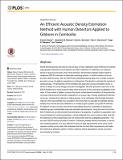Files in this item
An efficient acoustic density estimation method with human detectors applied to gibbons in Cambodia
Item metadata
| dc.contributor.author | Kidney, Darren | |
| dc.contributor.author | Rawson, Benjamin M. | |
| dc.contributor.author | Borchers, David Louis | |
| dc.contributor.author | Stevenson, Ben | |
| dc.contributor.author | Marques, Tiago A. | |
| dc.contributor.author | Thomas, Len | |
| dc.date.accessioned | 2016-05-20T12:30:06Z | |
| dc.date.available | 2016-05-20T12:30:06Z | |
| dc.date.issued | 2016-05-19 | |
| dc.identifier | 242358477 | |
| dc.identifier | edb57631-789d-40ba-a8a3-ccf6f70baced | |
| dc.identifier | 84982104066 | |
| dc.identifier | 000376291100027 | |
| dc.identifier.citation | Kidney , D , Rawson , B M , Borchers , D L , Stevenson , B , Marques , T A & Thomas , L 2016 , ' An efficient acoustic density estimation method with human detectors applied to gibbons in Cambodia ' , PLoS One , vol. 11 , no. 5 , e0155066 , pp. 1-16 . https://doi.org/10.1371/journal.pone.0155066 | en |
| dc.identifier.issn | 1932-6203 | |
| dc.identifier.other | ORCID: /0000-0002-7436-067X/work/29591655 | |
| dc.identifier.other | ORCID: /0000-0002-2581-1972/work/56861283 | |
| dc.identifier.other | ORCID: /0000-0002-3944-0754/work/72842463 | |
| dc.identifier.uri | https://hdl.handle.net/10023/8842 | |
| dc.description | D. Kidney was supported by an Engineering and Physical Sciences Research Council (EPSRC) Doctoral Training Grant studentship (EPSRC grant EP/P505097/1). B. Stevenson was supported by a studentship jointly funded by the University of St Andrews and EPSRC, through the National Centre for Statistical Ecology (EPSRC grant EP/I000917/1). | en |
| dc.description.abstract | Some animal species are hard to see but easy to hear. Standard visual methods for estimating population density for such species are often ineffective or inefficient, but methods based on passive acoustics show more promise. We develop spatially explicit capture-recapture (SECR) methods for territorial vocalising species, in which humans act as an acoustic detector array. We use SECR and estimated bearing data from a single-occasion acoustic survey of a gibbon population in northeastern Cambodia to estimate the density of calling groups. The properties of the estimator are assessed using a simulation study, in which a variety of survey designs are also investigated. We then present a new form of the SECR likelihood for multi-occasion data which accounts for the stochastic availability of animals. In the context of gibbon surveys this allows model-based estimation of the proportion of groups that produce territorial vocalisations on a given day, thereby enabling the density of groups, instead of the density of calling groups, to be estimated. We illustrate the performance of this new estimator by simulation. We show that it is possible to estimate density reliably from human acoustic detections of visually cryptic species using SECR methods. For gibbon surveys we also show that incorporating observers' estimates of bearings to detected groups substantially improves estimator performance. Using the new form of the SECR likelihood we demonstrate that estimates of availability, in addition to population density and detection function parameters, can be obtained from multi-occasion data, and that the detection function parameters are not confounded with the availability parameter. This acoustic SECR method provides a means of obtaining reliable density estimates for territorial vocalising species. It is also efficient in terms of data requirements since it only requires routine survey data. We anticipate that the low-tech field requirements will make this method an attractive option in many situations where populations can be surveyed acoustically by humans. | |
| dc.format.extent | 16 | |
| dc.format.extent | 603827 | |
| dc.language.iso | eng | |
| dc.relation.ispartof | PLoS One | en |
| dc.subject | GE Environmental Sciences | en |
| dc.subject | QA Mathematics | en |
| dc.subject | QH301 Biology | en |
| dc.subject | NDAS | en |
| dc.subject.lcc | GE | en |
| dc.subject.lcc | QA | en |
| dc.subject.lcc | QH301 | en |
| dc.title | An efficient acoustic density estimation method with human detectors applied to gibbons in Cambodia | en |
| dc.type | Journal article | en |
| dc.contributor.sponsor | EPSRC | en |
| dc.contributor.institution | University of St Andrews. Centre for Research into Ecological & Environmental Modelling | en |
| dc.contributor.institution | University of St Andrews. School of Mathematics and Statistics | en |
| dc.contributor.institution | University of St Andrews. Marine Alliance for Science & Technology Scotland | en |
| dc.contributor.institution | University of St Andrews. Scottish Oceans Institute | en |
| dc.contributor.institution | University of St Andrews. Pure Mathematics | en |
| dc.contributor.institution | University of St Andrews. Statistics | en |
| dc.identifier.doi | 10.1371/journal.pone.0155066 | |
| dc.description.status | Peer reviewed | en |
| dc.identifier.grantnumber | EP/I000917/1 | en |
This item appears in the following Collection(s)
Items in the St Andrews Research Repository are protected by copyright, with all rights reserved, unless otherwise indicated.

